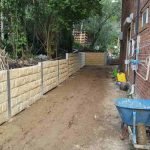Introduction
Building a retaining wall can be a transformative task for any property owner. Whether you're aiming to enhance your garden, stabilize your landscape, or add visual interest to your outdoor area, collaborating with your retaining wall specialist is vital for accomplishing the best outcomes. This comprehensive guide will explore how to effectively interact and work together with your professional, ensuring that your vision is recognized while likewise sticking to professional requirements. From choosing the ideal materials-- like lumber sleepers and concrete sleepers-- to comprehending the structural advantages of H beams, this article will equip you with the knowledge you need.
Collaborating with Your Retaining Wall Professional for Finest Results
1. Understanding the Role of a Retaining Wall Contractor
A retaining wall professional plays an essential role in any landscaping job including maintaining walls. They bring the know-how needed to ensure that your wall is not only visually pleasing but also structurally sound. Their responsibilities normally consist of:
- Design Consultation: Discussing your ideas and translating them into workable designs. Material Selection: Encouraging on ideal products such as wood sleepers, concrete sleepers, and H beams based upon sturdiness and cost. Project Management: Supervising building timelines, managing labor, and making sure compliance with local regulations.
2. Significance of Interaction in Collaboration
Clear communication is the bedrock of effective cooperation. Regular updates about project progress can prevent misunderstandings that may cause expensive hold-ups or revisions.
- Establishing Communication Channels: Settle on how you will interact-- whether through emails, phone calls, or in-person meetings. Setting Frequency of Updates: Decide how frequently you want updates relating to development or any issues that arise.
3. Preliminary Consultation: Setting Expectations
During the preliminary assessment phase, it's necessary to articulate what you anticipate from the task:
- Budget Constraints: Be upfront about what you're willing to spend. Design Preferences: Share images or sketches that represent your preferred style.
4. Choosing Products: Lumber Sleepers vs. Concrete Sleepers
One of the most important choices you'll make is picking materials for your retaining wall:
Timber Sleepers: Pros and Cons
- Pros: Aesthetic appeal, ease of installation. Cons: Prone to rot with time if not treated properly.
Concrete Sleepers: Pros and Cons
- Pros: Toughness and durability; resistant to weathering. Cons: Greater initial expense compared to timber.
5. Comprehending Structural Aspects: The Function of H Beams
H beams are an essential part of numerous retaining wall styles:
- Load-Bearing Capacity: They supply additional strength and support. Installation Strategies: Go over how these will be incorporated into your style plan.
6. Designing Your Retaining Wall: Collective Brainstorming
In this stage, both you and your specialist need to take part in conceptualizing sessions:
- Utilize style software application tools if available. Review regional building regulations together to ensure compliance.
Effective Job Management Strategies
7. Timeline Advancement: Setting Milestones
A well-defined timeline can assist keep the job on track:
Define major phases (e.g., style approval, product procurement). Set interim milestones to evaluate progress.8. Spending Plan Management: Avoiding Expense Overruns
Discussing spending plan management techniques is important:
- Keep track of all expenditures. Allow for contingency funds in case unforeseen costs arise.
9. Quality Assurance Practices
Quality guarantee ensures that every aspect fulfills industry requirements:
Discuss examination points throughout the process. Schedule follow-up assessments once building begins.Project Execution Phase: Interacting Smoothly
10. On-Site Cooperation: Regular Check-ins
Once work starts, keep routine check-ins with your contractor:
- Ask about daily progress. Address any issues immediately before they escalate.
11. Dealing With Modifications Midway Through Construction
Flexibility may be essential throughout building:
Ensure there's a clear procedure for initiating changes. Document everything in writing for accountability.Post-Construction Considerations
12. Last Examinations and Approvals
After building and construction wraps up, conduct a thorough assessment:
Assess visual quality versus initial plans. Check structural stability per local structure codes.13. Maintenance Tips for Your Retaining Wall
Proper maintenance extends the life of your retaining wall:
For Timber Sleepers
- Regularly examine for signs of rot or pests.
For Concrete Sleepers
- Check for cracks or indications of wear; address them promptly.
FAQs
Q1: For how long does it require to construct a retaining wall?
A1: The timeline varies based upon size and complexity however usually takes in between 1 week to several months.
Q2: What allows are required for constructing a keeping wall?
A2: Permits frequently depend upon regional guidelines; seek advice from your specialist who can browse these requirements effectively.
Q3: Can I install my own keeping wall?
A3: While do it yourself is possible, hiring specialists makes sure structural stability and compliance with structure codes.
Q4: What type of soil is best for supporting a retaining wall?

Q5: Are there ecological factors to consider in constructing a keeping wall?
A5: Yes! It's vital to think about drainage patterns and local https://anotepad.com/notes/3yxixk9k wildlife when preparing construction.
Q6: Is insurance required when hiring a contractor?
A6: Definitely! Making sure that specialists have appropriate insurance coverage protects you from liabilities during building work.
Conclusion
Collaborating with your retaining wall specialist for finest outcomes isn't just about laying bricks or stacking stones; it's about developing a partnership rooted in clear interaction, shared respect, and an undeviating dedication to quality workmanship. By following this comprehensive guide-- comprehending each phase from product selection like lumber sleepers or concrete sleepers through reliable task management-- you'll be set up for success in realizing your vision while ensuring structural stability through elements like H beams.
Remember that every successful partnership includes effort from both parties; remaining engaged throughout the procedure makes all the distinction in accomplishing exceptional results!